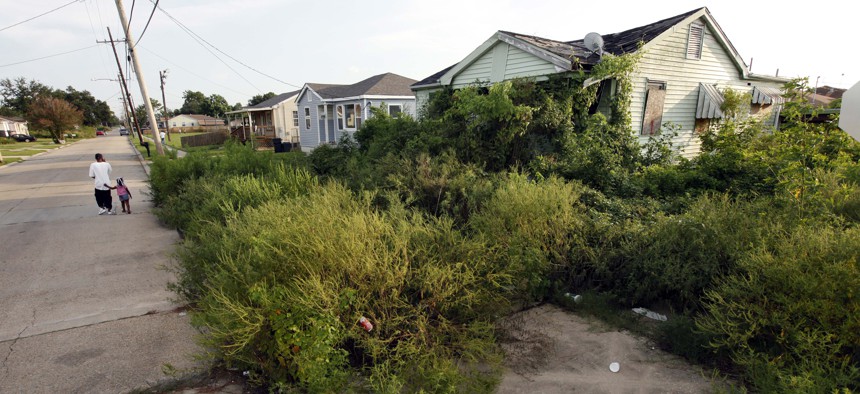Integrating Data Into City Hall

A man and child on Aug. 22, 2010 walk past a blighted home, destroyed by Hurricane Katrina and still abandoned five years after the storm, in the New Orleans East section of New Orleans. AP Photo/Gerald Herbert

Connecting state and local government leaders
COMMENTARY | How New Orleans used data in the rebuilding of a devastated city.
When I became mayor of New Orleans in 2010, our top job in City Hall was—quite simply—to rebuild. It had only been five years since Hurricane Katrina, and swaths of the city were still in disrepair or completely destroyed. Homes that could be fixed up needed to be rehabilitated quickly. Those that were too far gone or where an owner had walked away needed to be torn down.
But it wasn’t quite that simple. We had no idea how many homes fit into each category.
So we started to count. And count. And count, until we determined there were over 43,000 blighted and abandoned properties across our city, resulting in New Orleans having the highest rate of blighted property in the country. It was a staggering number—almost too big to get one’s head around—but knowing it gave us a place to get started.
We set an ambitious goal of reducing that number by 10,000 within four years. One of the core components of our strategy included holding monthly “BlightStat” meetings, where I’d gather staff from across a number of departments and residents to check our progress, troubleshoot tough cases, and update priorities. Using this data-driven process, we were able to clean up more than 15,000 blighted properties in those first four years, dramatically improving the quality of life in our neighborhoods and solidifying the city’s recovery.
The number of blighted properties wasn’t our only blind spot when I came into office. There was also no way to know, for example, how many cars the city owned or how many contracts the city had entered into. We didn’t have a good grasp on how many potholes we were filling or permits we were issuing. This dearth of data hurt our performance as a local government and, as a result, our city’s ability to attract people and businesses. I found that governing a city without data was like driving a car without a steering wheel. You just can’t do it.
That’s why, bit by bit, we changed the culture at City Hall. We not only created strong systems for collecting data, but also strong management structures for tracking our progress and holding agency leaders accountable for improvement. The same data-driven strategy that worked for tackling blight also worked when it came to speeding up ambulance response times, reducing the murder rate, and connecting our residents to job opportunities. Collecting, analyzing, and using data to govern became the DNA of all our decision-making.
Soon, New Orleans became a shining example of how a city can use data to drive better results for residents. Along the way, we worked closely with What Works Cities, a Bloomberg Philanthropies initiative that helps American cities up their game with data. It’s just one way former New York City Mayor Michael Bloomberg has led the way in pushing city leaders to put data at the center of local decision making.
Earlier this year, we were thrilled when New Orleans became one of the first nine cities to achieve What Works Cities Certification, a designation recognizing us as a well-managed, performance-focused city. We enjoyed that recognition alongside other high-performing U.S. cities led by excellent mayors such as Sly James in Kansas City, Eric Garcetti in Los Angeles, Greg Fischer in Louisville, Muriel Bowser in Washington, D.C. and others.
What Works Cities has updated the WWC Certification Assessment and is reaching out to every U.S. city with 30,000-plus residents to offer them the opportunity to engage. Taking the assessment gives cities the chance to understand their areas of strength and to get the help they need to improve. Cities that already have adopted many best practices can get on the path to get certified for the first time. Or, for cities like New Orleans that already are certified, it gives a chance to move up from a silver level of certification to gold, or even gold to platinum. My advice to mayors: Get involved now. This is about more than making good decisions. It’s also about being a great mayor, the CEO of a city where people and businesses want to locate and grow. The urge to act has to come from the top.
That means, first, making data a priority. And then, second, it means hiring excellent people who not only understand how to crunch numbers but also know how to work with top aides and department heads to use data to set and measure actionable goals. For me, that was Oliver Wise, who built and ran our Office of Performance and Accountability. Oliver’s team were the real brains behind most of our data-driven initiatives, including BlightStat.
Finally, this requires that mayors give people like Oliver the authority to shake things up throughout city hall. His team not only led broad citywide management efforts, they also trained people—from managers to frontline staff—on how to leverage the power of data. That ensured that we had a consistent approach, from top to bottom.
With better visibility and greater results, our commitment to using data-driven decision making grew stronger and stronger every year, and with it, our success in rebuilding one of America’s great cities.
Mitch Landrieu was mayor of New Orleans from May 2010 to May 2018.

NEXT STORY: Deadline extended for Federal 100 nominations!




